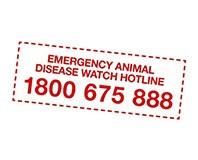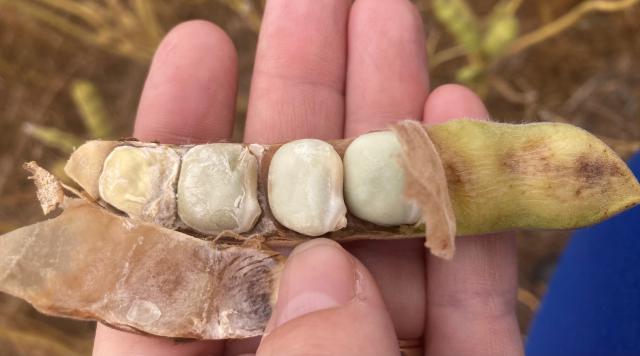WA Livestock Disease Outlook – for producers
Know the number - 1800 675 888
The Emergency Animal Disease (EAD) Hotline is a national toll-free telephone number that supports Australia’s general surveillance system for animal diseases by facilitating easy reporting of unusual disease signs in livestock, poultry or aquatic animals in Western Australia.
Your call will be answered 24 hours a day, 7 days a week by trained operators in the WA call centre.
Ensure you have this number saved in your phone:
When to call the EAD Hotline:
- suspicion of an exotic or emergency animal disease in livestock – for example: foot and mouth disease
- unusual disease signs, abnormal behaviour and/or unexpected deaths in your livestock
- suspicion of an exotic pest
- to report a Reportable Animal Disease in WA.
Who else can I call if my criteria doesn’t suit the EAD Hotline?
| Exotic plant pest hotline 1800 084 881 |
|
| Fishwatch WA 1800 815 507 |
|
| Wildcare helpline 08 9474 9055 |
|
| Your private veterinarian |
|
| DPIRD field veterinary officer |
|
Recent livestock disease investigations
Lupinosis detected in sheep in the Wheatbelt and Great Southern regions
Multiple properties across southern WA extending from the Wheatbelt region to the Great Southern have been impacted by lupinosis in sheep:
- One property in the Wheatbelt had 50 deaths and 330 affected from a flock of 1,500 over a period of 5 days. The mob consisted of 8 month old Merino lambs. The sheep were grazing a lupin crop stubble with supplementation of oaten hay. A rainfall event occurred two weeks prior to the sheep showing clinical signs.
- The affected lambs showed neurological signs, appearing blind with altered mentation and stargazing. Affected animals had no normal flight reaction.
- A DPIRD field veterinarian examined the sheep, conducted a post-mortem and submitted samples for laboratory testing.
- Testing at DDLS laboratory excluded lead toxicity, which can also present as blindness and lethargy in both sheep and cows and is a risk to human food safety and access to export markets if found in food-producing animals. Testing for Annual Ryegrass Toxicity (ARGT) was also negative.
- DDLS laboratory testing of the liver confirmed lupinosis as a diagnosis, which causes severe liver damage. Loss of liver function can lead to impaired brain function, which presents as neurological signs.
- Lupinosis is a liver disease caused by the consumption of lupin stubble colonised by the fungus Diaporthe toxica (previously called Phomopsis leptostromiformis). Acute lupinosis is most likely to occur after summer rains where the lupin stalk becomes softened and more palatable to livestock. All livestock are susceptible to lupinosis but sheep are the most susceptible. Weaners are most commonly affected because they tend to eat the stem of the lupin.
For more information, see the DPIRD webpage on Lupinosis in sheep.
Reportable infectious abortion agents of ewes ruled out by DPIRD
Abortion of over 30 lambs from mixed-aged merino and cross-bred ewes in confinement pens in the Great Southern region:
- Only a few pens were affected, both single and twin-bearing ewes, at 4 months pregnant. Ewes were of good body condition and up-to-date with vaccinations.
- The private veterinarian contacted a DPIRD field veterinary officer and was granted approval for subsidised testing via the Significant Disease Investigation (SDI) program.
- The veterinarian collected the appropriate base samples and additional diagnostic samples for submission to the laboratory.
- Laboratory testing for reportable causes of ovine abortion were negative, including Salmonella abortus ovis, enzootic abortion of ewes (Chlamydophilia abortus) and Brucella melitensis. It is important for Australian sheep export markets to be able to demonstrate continued freedom from enzootic abortion and exotic brucellosis and salmonellosis. Investigating abortion outbreaks in sheep can provide this evidence and increases confidence in our claims of freedom from these significant diseases of sheep.
- Laboratory testing for Campylobacteriosis returned a positive result.
- Testing for other infectious causes of abortions, including Leptospirosis and Toxoplasmosis, was negative.
- Campylobacter infections can cause late abortions and weak or stillborn lambs. The bacteria survives in the digestive system of some sheep and cattle, and is shed onto pasture. Vaccination for Campylobacter is available in Australia.
- Investigating abortion and infertility may also diagnose a zoonotic disease (one that can infect people). To protect your health, all producers handling lambing and aborting ewes should observe hygiene precautions and appropriate PPE such as gloves, eyewear and a face mask when handling aborted material. Producers working with sheep should discuss Q fever vaccination with their health professional. Listeriosis is particularly a concern for pregnant women: pregnant women should avoid handling aborting ewes.
For more information, see the DPIRD webpages on infertility and abortion in ewes and ovine campylobacteriosis.
In winter, be on the lookout for:
Arthritis in lambs
- Erysipelas is the most common cause of bacterial arthritis in lambs in WA and is caused by the bacteria Erysipelothrix rhusiopathiae.
- Lambs are most susceptible to infection soon after birth (via the umbilicus), or at marking, mulesing and shearing. Any break or wetting and softening of the skin can allow bacteria to enter and arthritis to develop.
- Prevention involves ensuring appropriate disinfection of equipment, hygienic mulesing and shearing practices in lambs, and avoiding wet, muddy conditions if mulesing, marking and shearing.
- Investigate the cause of lameness, particularly when more than one animal is affected, as a range of endemic diseases can cause lameness: footrot, foot abscesses, laminitis from grain overload, scabby mouth extending to the lower legs, rickets and white muscle disease. It is also vital to rule out exotic diseases including FMD and bluetongue virus.
- If erysipelas arthritis is a problem in your flock, discuss vaccination of your ewes with your veterinarian.
Read more on arthritis in sheep.
Pregnancy toxaemia in ewes
- Occurs when pregnant ewes do not receive enough nutrition.
- Low levels of glucose in the blood damage the brain and lead to dehydration, kidney failure and potentially death. Usually occurs in ewes with twin lambs and in the last weeks of pregnancy.
- Signs in affected ewes can include depression, not eating, weakness, nervous signs, down animals and death. Signs may be worse following stress events such as yarding.
- All pregnant ewes should be carefully managed. Adequate nutrition should be provided and stress events minimised.
- It is recommended to identify twin mothers using pregnancy scanning and then separate and preferentially feed them to minimise the risk of pregnancy toxaemia.
- A veterinarian can advise on treatment, which usually involves giving a drench containing glucose.
Read more on pregnancy toxaemia in sheep.
Grass tetany in sheep and cattle
- Magnesium deficiency or hypomagnesaemia
- Sheep at risk include pregnant and lactating ewes.
- Growing lambs are occasionally affected.
- Cattle at risk include older, highly productive cows in their first 4 months of lactation.
- Frequently occurs in winter/spring when grazing fast growing lush green pasture and crop.
- Often associated with cold weather, grazing grass-dominated pastures or recent topdressing with potassium (potash).
- Signs may include muscle twitching, convulsions, excitement, bellowing, apparent aggression, stiff gait and sudden death.
- Affected animals are typically found dead with paddle marks.
Read more on grass tetany in beef cattle.
If you see nervous signs in your livestock, phone a veterinarian. Some exotic diseases, such as transmissible spongiform encephalopathy (TSE), can cause similar signs. Testing helps to prove that WA is free from such diseases and further supports the industry.
Private veterinarian workshop to support animal disease surveillance in WA
Fifteen Western Australian veterinarians gathered in South Perth in July 2023 to attend the annual DPIRD private veterinary practitioner workshop. The event was coordinated by DPIRD Bunbury Field Veterinary Officer Dr Will Janson. These annual workshops are important in connecting private veterinarians working with livestock and DPIRD’s Animal Biosecurity and Welfare team.
The two-day workshop included both theory and practical sessions, covering a wide range of topics from a National and Global EAD update to post-mortem activities and sampling collection sites for neurological diseases.
Resources for producers for the 2023 season
DPIRD has a new webpage with information for producers for the 2023 season, including seasonal issues, livestock management, crop management, land and water management and updates on the climate situation and outlook.
The webpage Season 2023: information for WA farmers provides more information.
Livestock disease investigations protect our markets
Australia’s ability to sell livestock and livestock products depends on evidence from our surveillance systems to prove we are free of livestock diseases that are reportable or affect trade. The WA Livestock Disease Outlook for producers summarises recent significant disease investigations by Department of Primary Industries and Regional Development (DPIRD) veterinarians and private veterinarians that contribute to that surveillance evidence. Data from these investigations provides evidence that WA is free from these diseases and supports our continuing access to markets.
Find out more about WA's animal health surveillance programs.
Feedback
We welcome feedback. To provide comments or to subscribe to the monthly newsletter, email waldo@dpird.wa.gov.au.
To see previous issues of the WALDO – for producers, please visit our archive page


